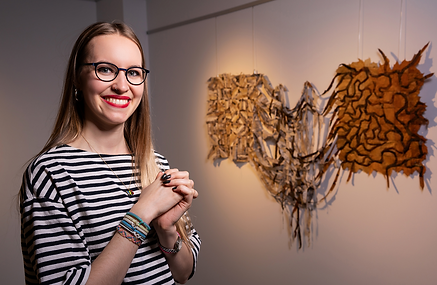
ABOUT
Juliana Scherzer is a textile artist based in Mississauga, Ontario working in free-motion machine embroidery and quilted leaves. Her work considers the role of humanity in the natural world through the subtle repetition of structures and patterns in deciduous trees, craft, the human body, and city environments.
After graduating from Sheridan College in 2018 with a Bachelor of Craft and Design, Scherzer has spent 2018 to 2021 as an artist-in-residence at the Cape Breton Centre for Craft and Design where, she continued to build her practice while branching out into production work and teaching a range of textile and art courses in the community. In Fall 2021 Juliana relocated to Toronto to start a residency in Harbourfront Centre's Craft and Design Studio.
Find a list of stockists here
Artist Statement
Juliana Scherzer works with preserved leaves to create pieces that reference historical craft aesthetics and natural structures. Societal shifts towards anthropocentrism have rendered the outdoors a foreign space, but our existence within its network is logical and essential. With this notion, we can take steps towards conservation, rehabilitation, restoration, and understanding where we belong and our responsibility to environmental stewardship. Using these ideas, Juliana creates quilts with fallen leaves and ecoprinted fabric, collecting leaves and preserving them in a water and glycerin mixture, keeping the leaves indefinitely flexible. The leaves are cut, sewn, and woven like fabric into modern, asymmetrical botanical quilts. These quilts connect patterns of nature with traditional forms of craft and the human body, questioning the metaphysical meaning of a material, its purpose, and what happens when it is manipulated beyond its intention and form.
Juliana’s most recent work explores these topics through themes of biology, mending, and environmentalism. In studying intersections and contrasts between the natural and the artificial with imagery drawn from craft and across the natural world, Juliana explores the place of humanity within these concepts. Similarities between these two seemingly opposite ideas are highlighted through the manipulation of organic materials with contemporary and traditional textile techniques, drawing upon repeating organic imagery of pathways, roots, veins, and woven structures. The work brings about reflection on the process of creation and humanity’s interaction with its environment, confronting one’s own individualism outside of nature and contemplation of their sense of place in relation to nature.
Let's Connect!
